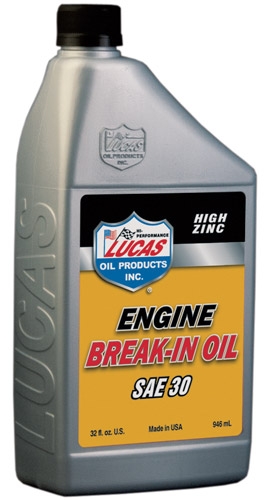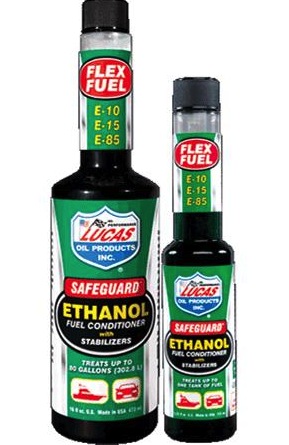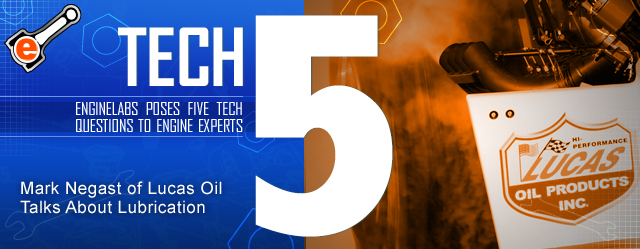TECH5 is a regular feature where EngineLabs asks industry leaders five technical questions. This week’s guest is Mark Negast, technical director for Lucas Oil.
EngineLabs: What’s the oil’s role during engine break-in, and what’s the Lucas strategy in formulating a break-in oil?
 Negast: Break-in oils are much different than traditional commercially available engine oils. First of all, they contain higher concentrations of anti-wear agents (phosphorous and zinc) and lower concentrations of detergents. You typically want break-in oils to be formulated with mineral-base oils since synthetics may be a little bit too slippery. You also want break-in oils to be non-friction modified. The higher concentration of zinc and phosphorous is important, especially in flat-tappet cams and lifters where there is a tremendous amount of boundary lubrication. Break-in oils do exactly what they say. They condition the lifters, cams and bearings, and the oil filter removes small amounts of metal shavings and debris that may remain after assembly. They effectively help seat the piston rings, which improves compression for improved performance. Lucas makes three grades of mineral oil based products (SAE 20, SAE 30 and SAE 20W-50). The selection of the grade really depends on the tolerances in your engine. If the tolerances are small then you want to use a thinner oil. If the tolerances are larger then you really want to use a heavier oil.
Negast: Break-in oils are much different than traditional commercially available engine oils. First of all, they contain higher concentrations of anti-wear agents (phosphorous and zinc) and lower concentrations of detergents. You typically want break-in oils to be formulated with mineral-base oils since synthetics may be a little bit too slippery. You also want break-in oils to be non-friction modified. The higher concentration of zinc and phosphorous is important, especially in flat-tappet cams and lifters where there is a tremendous amount of boundary lubrication. Break-in oils do exactly what they say. They condition the lifters, cams and bearings, and the oil filter removes small amounts of metal shavings and debris that may remain after assembly. They effectively help seat the piston rings, which improves compression for improved performance. Lucas makes three grades of mineral oil based products (SAE 20, SAE 30 and SAE 20W-50). The selection of the grade really depends on the tolerances in your engine. If the tolerances are small then you want to use a thinner oil. If the tolerances are larger then you really want to use a heavier oil.
EngineLabs: What is a “semi-synthetic” formula used in the Lucas engine-assembly lube, and what are the advantages as opposed to a full synthetic?
 Negast: Semi-Synthetic means that a portion of the formula is made with synthetic base stocks. There is no minimum requirement to classify a product as synthetic, but most manufacturers use between 10 to 25 volume percent. The advantages of using a semi-synthetic assembly lube is cost. The assembly lube is only on the parts being treated for a short amount of time during storage and transportation periods. Once the engine is started the assembly lube is assimilated into the oil. Typically both semi-synthetic and full synthetic assembly lubes contain tackifiers to help the product adhere to the assembled parts during storage periods.
Negast: Semi-Synthetic means that a portion of the formula is made with synthetic base stocks. There is no minimum requirement to classify a product as synthetic, but most manufacturers use between 10 to 25 volume percent. The advantages of using a semi-synthetic assembly lube is cost. The assembly lube is only on the parts being treated for a short amount of time during storage and transportation periods. Once the engine is started the assembly lube is assimilated into the oil. Typically both semi-synthetic and full synthetic assembly lubes contain tackifiers to help the product adhere to the assembled parts during storage periods.
EngineLabs: Racers are always looking to stretch their dollars, so what’s the best strategy for determining when oil should be changed?
Negast: It kind of depends on the kind of fuel that you are using and the types of racing. If you are using alcohol or nitro-methane then you are going to have a tremendous amount of fuel dilution that may affect the ability of the oil to lubricate for long periods of time. Some racers actually boil off the alcohol to extend the life of the oil. Typically the best way to determine how long you can use an oil is to do a used-oil testing program. By doing this you can tell what kind of wear metals you are getting and at what point the oil degrades and then determine the optimum drain interval. There is really no canned answer for this question. The cost of used oil analysis is just about $25, and you get results back quickly.
EngineLabs: If a racer uses a quality oil and changes the oil regularly, is there a need for any type of oil additive?
 Negast: If the racer is using a high-quality racing oil with high zinc and phosphorus levels, then there is probably not a need for supplements. If the racer is using a typical API licensed passenger car oil then they may want to add high-zinc supplements and possibly a high-viscosity oil stabilizer to provide protection to their flat-tappet cams and lifters.
Negast: If the racer is using a high-quality racing oil with high zinc and phosphorus levels, then there is probably not a need for supplements. If the racer is using a typical API licensed passenger car oil then they may want to add high-zinc supplements and possibly a high-viscosity oil stabilizer to provide protection to their flat-tappet cams and lifters.
EngineLabs: How does an ethanol stabilizer work and why is it needed for some cars?
Negast: Ethanol stabilizers typically contain heavy doses of rust and corrosion inhibitors to combat the corrosive effects of alcohol in gasoline. What happens is as the percentage of water builds up in gasoline which is really important in marine applications, the fuel, alcohol and water separates into phases and the water creates the major problem in combustion and rusting. Ethanol stabilizers typically contain detergent additives as well to help keep the entire fuel system clean. Some ethanol stabilizers even claim to resolubalize the water back into the ethanol, fuel phase. This is done by adding more alcohol which is the major component of many additives, more ethanol fuel or emulsifiers all of which can be detrimental to the fuel system.


















